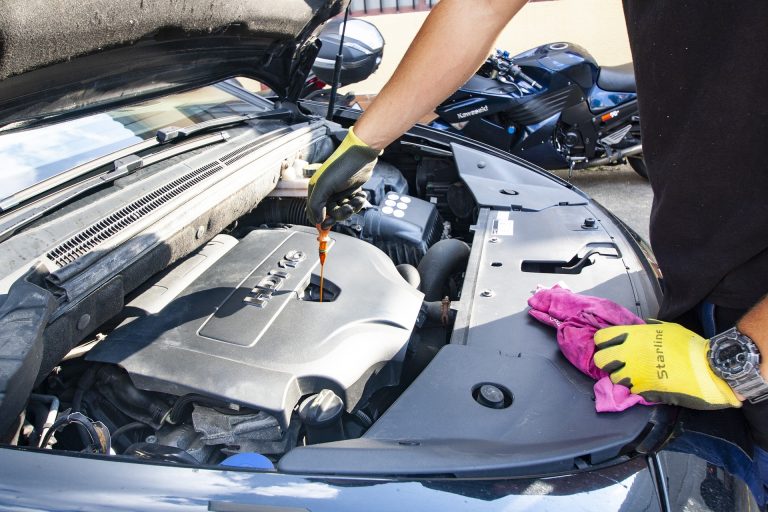Keeping your vehicle’s fluids topped up is essential for its longevity and smooth running. Neglecting fluid levels can lead to costly breakdowns and premature wear on components. While mechanics handle fluid changes during services, it’s wise to check levels yourself occasionally between services.
The UK’s FREE vehicle maintenance reminder service.
Road tax, MOT, insurance & maintenance alerts totally FREE.
Helping 1,000’s of UK drivers avoid penalties & stay legal on the road.
This beginner’s guide covers how to check and top up the main fluids in your car, van or motorbike. We’ll look at engine oil, coolant, brake fluid, power steering fluid, screenwash and battery electrolyte levels. With a few simple steps and basic tools, it’s straightforward to maintain optimum fluid levels yourself.
Engine Oil
One of the most crucial fluids is your engine oil. This lubricates the rapidly moving internal components, reducing friction and wear. It also helps keep the engine clean inside.
Checking the level is easy – first ensure the vehicle is parked on level ground and the engine is cold. Open the bonnet and locate the dipstick, usually a brightly coloured loop sticking out of the engine. Pull it out, wipe it clean with a rag, then reinsert it fully. Withdraw it again and check the level. There are min and max markings on the stick – the oil level should be between these.
If it’s below the minimum, you’ll need to top it up. Locate the filler cap on the engine and unscrew it. Pour in small amounts of the manufacturer’s recommended oil until the level is correct. Be very careful not to overfill as this can cause problems too. Top up a little at a time, checking the level frequently.
Engine Coolant
The coolant (also called antifreeze) circulates through passages in the engine, drawing away excess heat to keep temperatures in check. Without it, the engine would rapidly overheat and fail.
When the engine is cold, the coolant level should be between the minimum and maximum markings on the translucent plastic overflow reservoir. If it’s low, prepare a 50/50 mix of concentrated coolant and distilled water to top it up. Don’t use undiluted coolant or tap water.
Coolant should be replaced every few years as its corrosion inhibitors gradually get used up. Always dispose of old coolant safely and responsibly.
Brake Fluid
Your vehicle’s brakes rely on hydraulic brake fluid to transmit foot pedal pressure into braking force at the wheels. Low fluid can cause brake failure, so maintaining the correct level is vital for safety.
Locate the transparent plastic brake fluid reservoir – it may be around the back of the engine bay or inside near the brake pedal. The level should be between the minimum and maximum markings. Top up with new, clean DOT-approved brake fluid if it’s low.
Brake fluid is hygroscopic, so it gradually absorbs moisture from the air which can cause corrosion in the brake lines. For this reason, it needs fully renewing every 2-3 years.
Power Steering Fluid
Many vehicles have hydraulic power steering to reduce the effort needed to turn the steering wheel. The fluid level needs checking periodically.
When the engine is warm and running, inspect the level in the power steering reservoir (often tan or yellow in colour). Top up with the recommended fluid if low.
Screenwash
Having plenty of good screenwash in the reservoir is important for maintaining a clear view out of the windscreen in poor weather conditions. Never use pure water as this can freeze and crack the reservoir.
Simply unscrew the cap and pour in a mix of premixed screenwash concentrate and water to bring the level up to the full mark. In winter, use a stronger screenwash solution with better de-icing capability.
Lead-Acid Battery
Finally, if your vehicle has a conventional lead-acid battery, you may need to top up the electrolyte level in each cell occasionally. This involves removing the battery cover and carefully adding distilled water until the level is correct.
Always exercise caution, as the fluid in the battery is acid and dangerous. Only perform this if you are competent around dangerous fluids. and ensure you always use protective equipment (PPE), such as glasses, gloves, etc.
However, modern batteries are increasingly sealed for life so check your owner’s manual first. Never remove the caps if the battery is sealed as you could reduce its lifespan.
The Bottom Line
To summarise, regularly checking and maintaining the correct levels of these key fluids is straightforward and worthwhile. It can prevent potentially costly problems down the line.
Beyond these basics, you’ll also want to ensure your tyre pressures and tread depths are legal and safe. You should check lights, windscreen wipers and other core safety items frequently too. When it comes to major fluid replacements and complex maintenance tasks, it’s usually wise to entrust these to a qualified mechanic.
Being an attentive owner and addressing any small issues promptly will give you maximum reliability and longevity from your vehicle. Proper maintenance really does pay dividends in the long run.

